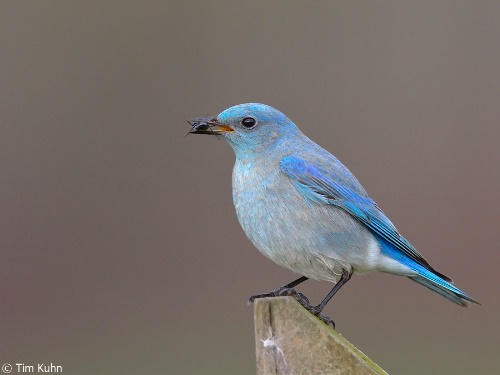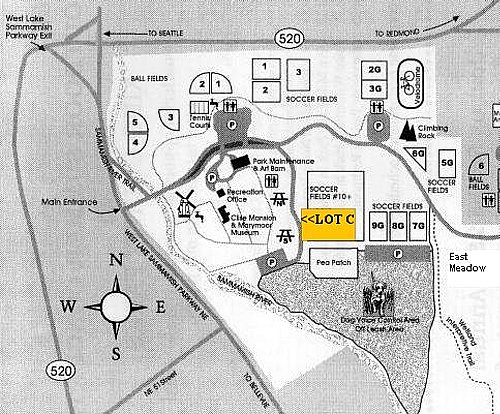|
Friends of Marymoor Park This Mountain Bluebird was in the east meadow on 4/11/2003, By Michael Hobbs birdmarymoor@gmail.com Marymoor Park, located at the north end of Lake Sammamish in Redmond, has been called the jewel of the King County parks system. At over 600 acres it is quite large for a suburban park. It is also one of the most heavily used parks around with more than 1,200,000 visitors annually. Much of the park has been developed for active recreational usage with soccer fields, tennis courts, softball diamonds, picnic areas, a velodrome for bicycle racers, a rock climbing wall, an R/C model airplane park, and one of the largest off-leash dog area in the county. However, the park also features large natural areas and a 1.5-mile-long nature trail. The birding possibilities at Marymoor should not be overlooked. I’ve been going birdwatching at Marymoor Park every week since April 1994. For the preceding four years I had birded only in the spring, until I realized that the birding was good there all year round. In the 700+ visits I’ve made, I’ve been rewarded with sightings of 190 species, including several species which are unusual for King County. At least 50 species can be seen at Marymoor on a weekday morning any week of the year, with spring and fall totals often approaching 65-70. In the summer, the park is host to many breeding species, including Pied-billed Grebe, Wood Duck, Bald Eagle, Red-tailed Hawk, Barn Owl, Virginia Rail, Rufous Hummingbird, Willow Flycatcher, Red-eyed and Warbling Vireos, Bewick’s and Marsh Wrens, Swainson’s Thrush, Cedar Waxwing, Yellow Warbler, Common Yellowthroat, Savannah Sparrow, Black-headed Grosbeak, and, unfortunately, Brown-headed Cowbird. In past decades, Purple Martins were known to breed in pilings at the northeast corner of the lake. They nested again in 2003, and we hope to have them breeding regularly again. In the winter, ducks are numerous, and sparrow watching can be quite good, with Song, White-crowned, Golden-crowned, Fox, and Lincoln's Sparrows being common. Raptors are also common, notably Red-tailed, Cooper’s, and Sharp-shinned Hawks, and Bald Eagles. Marymoor Park is also a good place to find birds more typically associated with eastern Washington. Mourning Dove, Mountain Bluebird, Ash-throated Flycatcher, Eastern and Western Kingbird, Nashville Warbler, Lazuli Bunting, and Say’s Phoebe have all been recorded in the park multiple times, mostly during migration. The nature trail features the best birding opportunities. It runs from the dog area parking lot, south along the slough to a lake platform, then turns northeast, and runs back to its nominal start at the nature trail parking lot. I walk it “backwards” as described here, since I like to walk the slough earlier in the morning. Because of heavy use on weekends, weekday mornings are usually the best time to visit. Click here for views of the trail The slough portion runs through riparian habitat. This area was impacted heavily by off-leash dogs, damage that the Corps of Engineers and SODA (the dog-area advocacy group) have done a lot of mitigation work. This area is very good for sparrows in winter and for Willow Flycatcher, Common Yellowthroat, and Wilson’s and Orange-crowned Warbler in spring and summer. Western Tanager are often seen here in migration. The slough itself is great for ducks, coots, grebe, Belted Kingfisher, Green Heron, Wilson's Snipe, and American Bittern. Check the air above for five species of swallow and for Vaux’s Swift in spring and summer. Especially in June, look for large numbers (50-100) of black swift above the slough or the lake. South of the dog area, the trail goes through the largest forested portion of the park – a particularly good place to find both Red-eyed and Warbling Vireo, as well as Western Wood-Pewee. In winter, check the larger trees for roosting Great Blue Heron. There are a few places where you can see into the slough from this section. In summer, look for Spotted Sandpiper on the lily pads. Tree Swallows, Green Heron, and Wood Duck nest near here as well. The portion of the trail near the lake is on a raised boardwalk. During late spring and summer, check the area where the boardwalk starts for Wilson’s and Yellow Warbler, and for Cedar Waxwing, Red-breasted Sapsucker, and Downy Woodpecker. In 1998, a Red-eyed Vireo nested just above the trail there. At the lake platform, scan the waters for Western, Horned, and Pied-billed Grebe, Common Loon, and just about any species of duck in winter, and check the trees for Bald Eagle. Pied-billed Grebes have nested within 15 feet of the platform a couple of times. Gulls, harriers, or osprey may also be seen, and rarely, Caspian Tern and Bonaparte’s Gull. After the lake platform, the boardwalk turns northeast and runs through a nice cattail marsh which, despite being infested with purple loosestrife and garden loosestrife, is very good for Marsh Wren and Virginia rail. During May, June, and July, you can usually see a male Rufous Hummingbird perched on top of one of the short trees there. At the end of the boardwalk is another stand of tall trees which can be very good for Black-headed Grosbeak and Swainson’s Thrush in summer. A Blue-gray Gnatcatcher was found in the ash trees there in October, 1999; at the time only the fourth state record for that species. The trail then goes through some low shrubbery and twists its way to a small footbridge. The hundred feet preceding the footbridge can occasionally be filled with birds – one day, on this very short stretch, I found over 20 species. Around the footbridge, Long-tailed Weasel can sometimes be seen. After the footbridge, the trail runs along the edge of the east meadow, home to many Savannah Sparrow in summer. It is one of the commonest places to see coyote in the park. In winter it is the best place to check for Northern Shrike and Western Meadowlark. This is the area where Mountain Bluebirds have been observed several times during spring migration, and where Ash-throated Flycatcher has been seen twice. The meadow is also used by Northern Harriers in migration and by Short-eared Owls in fall and winter. To make the trail a loop, you can either cut through the dog area or walk along the south edge of the grass soccer fields just north of "Snag Row". In spring and summer, the dog-area route can be rewarding, especially if you check the row of willows for birds. In fall, we have found Lapland Longspur and Vesper Sparrow in the northeast corner of the Dog Meadow. The soccer fields are excellent in fall and winter for Mew Gull, geese, including Canada and Cackling and the occasional Greater White-fronted. American Pipit can often be found in fall on the fields as well. In the fall of 2004, a Buff-breasted Sandpiper was found; later the same fall a Pectoral Sandpiper appeared, both with Killdeer flocks. On August 30, 2005, the state's first Smith's Longspur was eating grass seed on the grass soccer fields amongst a large flock of House Finches. Other parts of the park are also good for birds. Clise Mansion, at the heart of Marymoor Park, was built in 1904 as a hunting lodge for Seattle businessman James W. Clise, on property he called “Willowmoor.” Around the mansion are just about the only conifers in the park; they are worth checking for their associated species such as Chestnut-backed Chickadee, Golden-crowned Kinglet, and Townsend’s Warbler. The non-native plantings around the mansion can be good during spring migration for Western Tanager, Bullock’s Oriole, and a variety of warblers. In the pre-dawn or in evening, check the cedars near the windmill for Barn Owl. On the other side of the slough, the Marymoor West unit offers some different birding possibilities. You can park at the rowing club parking lot off West Lake Sammamish Parkway (at about 48th St.), and walk to the slough. Along the path are three ponds that have proven good for the shyer ducks. More trails are planned, and this area may eventually rival the nature trail for birding opportunities in the park. To get to Marymoor Park, take SR 520 east from Seattle to the West Lake Sammamish Parkway exit and follow the signs. The entrance to the park is one block south of the exit. How to Get There Home | Mission | Members | Events | News | Maps | Getting There | Contact Us | Links | Search Problems, comments, suggestions? Email the FOMP webmaster at webmaster@marymoor.org |


